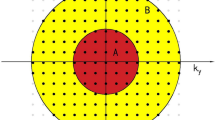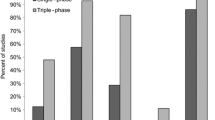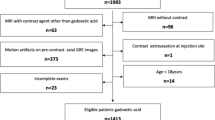Abstract
Objectives
To assess the usefulness of multiple arterial phase (AP) of gadoxetic acid-enhanced MRI using view-sharing of two different vendors to reduce transient severe motion (TSM) artifact in the AP.
Methods
This retrospective study included 298 patients (mean age 63 years) who underwent gadoxetic acid MRI with multiple AP from two different vendors; either triple (subcohort A, n=174) or quadruple (subcohort B, n=124) AP. 202 patients (143 vs. 59) underwent follow-up MRI with single AP. To compare multiple AP with single AP and between subcohorts, mean artifact score rated by two observers and frequency of significant artifacts were evaluated. Frequency of acquisition of late AP was also assessed.
Results
There was no difference in mean artifact score (p=0.086) or frequency of significant artifacts (p=0.219) between multiple AP and single AP. For the mean best score with multiple AP, subcohort B was better than subcohort A (p<0.001). Late AP was achieved more often with multiple AP (74.8 %, 98.3 %) than with single AP (64.3 %, 64.4 %).
Conclusion
Multiple AP using different view-sharing failed to show differences in TSM artifacts in AP compared to single AP. Frequency of acquisition of late AP was higher with multiple AP. Mean best artifact score of multiple AP is different depending on view-sharing technique.
Key Points
• TSM artifacts were not significantly different between multiple AP and single AP.
• The frequency of acquiring late AP was higher with multiple AP.
• For multiple APs, TSM artifacts are different according to view-sharing technique.





Similar content being viewed by others
Abbreviations
- AP:
-
Arterial phase
- BMI:
-
Body mass index
- CAIPRINHA:
-
Controlled aliasing in parallel imaging results in higher acceleration
- CENTRA:
-
Contrast-enhanced time robust angiography
- COPD:
-
Chronic obstructive pulmonary disease
- MRI:
-
Magnetic resonance imaging
- SENSE:
-
Sensitivity encoding
- TRAK:
-
Time-resolved angiography with keyhole
- TSM:
-
Transient severe motion
- TWIST:
-
Time-resolved imaging with interleaved stochastic trajectories
- VIBE:
-
Volumetric interpolated breath-hold examination
References
Vogl TJ, Kummel S, Hammerstingl R et al (1996) Liver tumors: comparison of MR imaging with Gd-EOB-DTPA and Gd-DTPA. Radiology 200:59–67
Huppertz A, Balzer T, Blakeborough A et al (2004) Improved detection of focal liver lesions at MR imaging: multicenter comparison of gadoxetic acid-enhanced MR images with intraoperative findings. Radiology 230:266–275
Ahn SS, Kim MJ, Lim JS, Hong HS, Chung YE, Choi JY (2010) Added value of gadoxetic acid-enhanced hepatobiliary phase MR imaging in the diagnosis of hepatocellular carcinoma. Radiology 255:459–466
Sun HY, Lee JM, Shin CI et al (2010) Gadoxetic acid-enhanced magnetic resonance imaging for differentiating small hepatocellular carcinomas (< or =2 cm in diameter) from arterial enhancing pseudolesions: special emphasis on hepatobiliary phase imaging. Invest Radiol 45:96–103
Motosugi U, Ichikawa T, Sou H et al (2010) Distinguishing hypervascular pseudolesions of the liver from hypervascular hepatocellular carcinomas with gadoxetic acid-enhanced MR imaging. Radiology 256:151–158
Park MJ, Kim YK, Lee MW et al (2012) Small hepatocellular carcinomas: improved sensitivity by combining gadoxetic acid-enhanced and diffusion-weighted MR imaging patterns. Radiology 264:761–770
Pietryga JA, Burke LM, Marin D, Jaffe TA, Bashir MR (2014) Respiratory motion artifact affecting hepatic arterial phase imaging with gadoxetate disodium: examination recovery with a multiple arterial phase acquisition. Radiology 271:426–434
Park YS, Lee CH, Kim IS et al (2014) Usefulness of controlled aliasing in parallel imaging results in higher acceleration in gadoxetic acid-enhanced liver magnetic resonance imaging to clarify the hepatic arterial phase. Invest Radiol 49:183–188
Kim SM, Heo SH, Kim JW et al (2014) Hepatic arterial phase on gadoxetic acid-enhanced liver MR imaging: a randomized comparison of 0.5 mL/s and 1 mL/s injection rates. Korean J Radiol 15:605–612
Tamada T, Ito K, Yoshida K et al (2011) Comparison of three different injection methods for arterial phase of Gd-EOB-DTPA enhanced MR imaging of the liver. Eur J Radiol 80:e284–e288
Kim YK, Lin WC, Sung K et al (2017) Reducing Artifacts during Arterial Phase of Gadoxetate Disodium-enhanced MR Imaging: Dilution Method versus Reduced Injection Rate. Radiology 283:429–437
Johnson CP, Polley TW, Glockner JF, Young PM, Riederer SJ (2013) Buildup of image quality in view-shared time-resolved 3D CE-MRA. Magn Reson Med 70:348–357
Yoon JH, Lee JM, Yu MH, Kim EJ, Han JK (2016) Triple Arterial Phase MR Imaging with Gadoxetic Acid Using a Combination of Contrast Enhanced Time Robust Angiography, Keyhole, and Viewsharing Techniques and Two-Dimensional Parallel Imaging in Comparison with Conventional Single Arterial Phase. Korean J Radiol 17:522–532
Biglands JD, Radjenovic A, Ridgway JP (2012) Cardiovascular magnetic resonance physics for clinicians: Part II. J Cardiovasc Magn Reson 14:66
Beck GM, De Becker J, Jones AC, von Falkenhausen M, Willinek WA, Gieseke J (2008) Contrast-enhanced timing robust acquisition order with a preparation of the longitudinal signal component (CENTRA plus) for 3D contrast-enhanced abdominal imaging. J Magn Reson Imaging 27:1461–1467
Willinek WA, Gieseke J, Conrad R et al (2002) Randomly segmented central k-space ordering in high-spatial-resolution contrast-enhanced MR angiography of the supraaortic arteries: initial experience. Radiology 225:583–588
Hadizadeh DR, Gieseke J, Beck G et al (2011) View-sharing in keyhole imaging: Partially compressed central k-space acquisition in time-resolved MRA at 3.0 T. Eur J Radiol 80:400–406
Hadizadeh DR, von Falkenhausen M, Gieseke J et al (2008) Cerebral arteriovenous malformation: Spetzler-Martin classification at subsecond-temporal-resolution four-dimensional MR angiography compared with that at DSA. Radiology 246:205–213
Budjan J, Ong M, Riffel P et al (2014) CAIPIRINHA-Dixon-TWIST (CDT)-volume-interpolated breath-hold examination (VIBE) for dynamic liver imaging: comparison of gadoterate meglumine, gadobutrol and gadoxetic acid. Eur J Radiol 83:2007–2012
Michaely HJ, Morelli JN, Budjan J et al (2013) CAIPIRINHA-Dixon-TWIST (CDT)-volume-interpolated breath-hold examination (VIBE): a new technique for fast time-resolved dynamic 3-dimensional imaging of the abdomen with high spatial resolution. Invest Radiol 48:590–597
Hammer S, Uller W, Manger F, Fellner C, Zeman F, Wohlgemuth WA (2017) Time-resolved magnetic resonance angiography (MRA) at 3.0 Tesla for evaluation of hemodynamic characteristics of vascular malformations: description of distinct subgroups. Eur Radiol 27:296–305
Davenport MS, Viglianti BL, Al-Hawary MM et al (2013) Comparison of acute transient dyspnea after intravenous administration of gadoxetate disodium and gadobenate dimeglumine: effect on arterial phase image quality. Radiology 266:452–461
Davenport MS, Caoili EM, Kaza RK, Hussain HK (2014) Matched within-patient cohort study of transient arterial phase respiratory motion-related artifact in MR imaging of the liver: gadoxetate disodium versus gadobenate dimeglumine. Radiology 272:123–131
Bashir MR, Castelli P, Davenport MS et al (2015) Respiratory motion artifact affecting hepatic arterial phase MR imaging with gadoxetate disodium is more common in patients with a prior episode of arterial phase motion associated with gadoxetate disodium. Radiology 274:141–148
Semelka RC, Martin DR, Balci NC (2006) Magnetic resonance imaging of the liver: how I do it. J Gastroenterol Hepatol 21:632–637
Hope TA, Saranathan M, Petkovska I, Hargreaves BA, Herfkens RJ, Vasanawala SS (2013) Improvement of gadoxetate arterial phase capture with a high spatio-temporal resolution multiphase three-dimensional SPGR-Dixon sequence. J Magn Reson Imaging 38:938–945
Murakami T, Kim T, Takamura M et al (2001) Hypervascular hepatocellular carcinoma: detection with double arterial phase multi-detector row helical CT. Radiology 218:763–767
Im WH, Song JS, Park EH, Kwak HS (2017) Transient severe motion in the arterial phase during gadoxetate disodium-enhanced MR imaging: evaluation of patients with multiple MR examinations. Abdom Radiol (NY)
Acknowledgements
The authors thank Philips and Siemens Research Laboratories for their technical support and advice to perform this study.
Funding
The authors state that this work has not received any funding.
Author information
Authors and Affiliations
Corresponding author
Ethics declarations
Guarantor
The scientific guarantor of this publication is Young Kon Kim in Department of Radiology and Center for Imaging Science, Samsung Medical Centre, Sungkyunkwan University School of Medicine, Seoul, Republic of Korea
Conflict of interest
The authors of this manuscript declare no relationships with any companies, whose products or services may be related to the subject matter of the article.
Statistics and biometry
Soohyun Ahn PhD. and Na Young Hwang MS in Biostatistics and Clinical Epidemiology Centre, Research Institute for Future Medicine, Samsung Medical Centre, Seoul, Korea kindly provided statistical advice for this manuscript.
One of the authors has significant statistical expertise.
Ethical approval
Institutional Review Board approval was obtained.
Informed consent
Written informed consent was waived by the Institutional Review Board.
Methodology
• Retrospective
• Observational
• Performed at one institution
Electronic supplementary material
ESM 1
(DOCX 21 kb)
Rights and permissions
About this article
Cite this article
Min, J.H., Kim, Y.K., Kang, T.W. et al. Artifacts during the arterial phase of gadoxetate disodium-enhanced MRI: Multiple arterial phases using view-sharing from two different vendors versus single arterial phase imaging. Eur Radiol 28, 3335–3346 (2018). https://doi.org/10.1007/s00330-018-5307-4
Received:
Revised:
Accepted:
Published:
Issue Date:
DOI: https://doi.org/10.1007/s00330-018-5307-4




